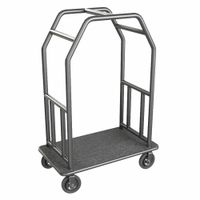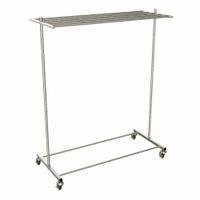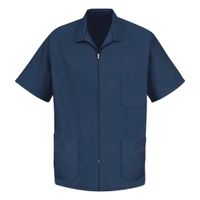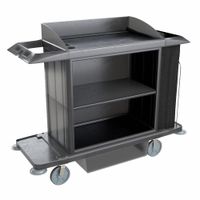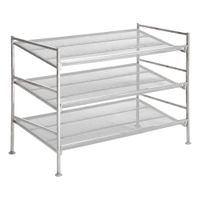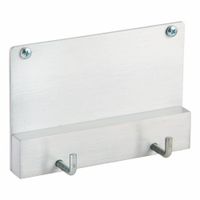Call +(254) 703 030 000 / 751 483 999 / 721 704 777
- Home
- Furnishings Appliances Hospitality
- Hospitality Supplies
Frequently Asked Questions
What are the essential housekeeping supplies needed for room service?
Please specify the topic you would like me to elaborate on.
How do hospitality uniforms enhance brand awareness in hotels?
Hospitality uniforms play a crucial role in enhancing brand awareness for hotels by serving as a constant visual representation of the brand. Firstly, a well-designed uniform creates a sense of professionalism and consistency among staff, projecting a unified image that guests associate with the hotel's standards and quality. When employees look cohesive and polished, it instills confidence in the guests and reinforces the hotel's commitment to excellent service.
Secondly, uniforms can incorporate key brand elements such as the hotel's logo, colors, and specific design motifs. This immediate visual recognition helps to differentiate the hotel from competitors and makes a lasting impression on guests. For instance, a distinctive uniform can become an iconic part of the guest experience, making the hotel more memorable and shareable.
Furthermore, uniforms contribute to the overall ambiance and theme of the hotel. Whether it's a modern, minimalist design or a more traditional, luxurious look, the uniform can subtly communicate the hotel's unique personality and target demographic. This aligns with the hotel's marketing efforts and helps to attract guests who resonate with its particular style.
Finally, uniforms can also enhance the guest experience by clearly identifying staff members, making it easier for guests to seek assistance or ask questions. This accessibility and helpfulness contribute to a positive perception of the brand, leading to increased guest satisfaction and loyalty. In essence, hospitality uniforms are not just clothing; they are powerful branding tools that contribute significantly to a hotel's identity and market presence.
What features should I look for in a bellman cart?
When choosing a bellman cart, consider several key features to ensure it meets your needs for durability, functionality, and aesthetics.
First, focus on construction materials. Stainless steel or polished brass frames are popular for their strength and resistance to corrosion, ensuring a long lifespan. The deck, where luggage rests, should be reinforced and often features a carpeted surface to prevent scratches and provide grip.
Next, evaluate the wheels. Large, non-marking swivel wheels (typically 6-8 inches in diameter) are essential for smooth maneuverability and quiet operation across various floor surfaces, including carpets, tiles, and pavement. Look for wheels with rubber or polyurethane treads for optimal performance.
Consider the design and capacity. Carts come in various styles, including traditional upright designs and more compact folding options. The size and weight capacity should align with the typical volume and weight of luggage your establishment handles. A protective bumper around the cart’s base is crucial to prevent damage to walls and doorways.
Finally, assess additional features. Some carts include garment hooks for hanging clothes, brakes on the wheels for secure parking, and decorative elements that match your establishment's decor. A well-designed bellman cart enhances guest experience and staff efficiency.
How can garment racks and coat hooks improve guest experience?
Garment racks and coat hooks can significantly enhance the guest experience by offering practical convenience and a sense of thoughtful hospitality. Guests often arrive with coats, bags, or other items they prefer to hang rather than place on furniture or the floor. Providing a dedicated space for these belongings helps keep the room tidy and organized, which contributes to a more pleasant and comfortable stay. It also eliminates the need for guests to search for available hanging space or drape items over chairs, which can feel cluttered and inconvenient.
Beyond practicality, the presence of garment racks and coat hooks signals that the host has anticipated and considered the guest's needs, adding a touch of personalized care. This attention to detail can leave a lasting positive impression, making guests feel valued and welcomed. For longer stays, or when guests have multiple items of clothing, a garment rack can be particularly useful, allowing clothes to air out and remain wrinkle-free. Ultimately, these simple additions contribute to a more seamless, comfortable, and appreciative guest experience.
What are the benefits of using shoe racks in hotel rooms?
Using shoe racks in hotel rooms offers several benefits for both guests and hotel operations. For guests, shoe racks help maintain a tidy and organized space, preventing shoes from cluttering the floor or being misplaced. This enhances the overall comfort and convenience of their stay, making it easier to find their footwear and reducing the risk of tripping hazards.
From a hotel's perspective, shoe racks contribute to better room presentation and easier housekeeping. When shoes are neatly stored, it simplifies the cleaning process for staff, allowing them to quickly and efficiently tidy the room. It also helps preserve the quality of the room's carpets or flooring by minimizing direct contact with dirty shoe soles. Furthermore, providing shoe racks can be perceived as an added amenity, reflecting attention to detail and enhancing the guest experience, potentially leading to higher guest satisfaction and positive reviews. It demonstrates a commitment to providing a comfortable and organized environment.
How do umbrella stands help maintain cleanliness in hotel lobbies?
Umbrella stands are simple yet effective tools for maintaining cleanliness in hotel lobbies by providing a designated place for guests to store wet umbrellas. This prevents water from dripping onto floors, which can lead to several problems. Firstly, wet floors are a slip-and-fall hazard, increasing the risk of accidents for guests and staff. By containing water, umbrella stands reduce this danger.
Secondly, dripping umbrellas can track dirt and grime into the lobby, especially during inclement weather. This dirt can be spread throughout the hotel by foot traffic, making it more challenging and time-consuming to clean. Umbrella stands help to confine this moisture and dirt to a specific area, making it easier for housekeeping to manage and maintain the lobby's appearance.
Thirdly, constant moisture can damage flooring, especially carpets and hardwood. Prolonged exposure to water can lead to mildew, stains, and deterioration, necessitating costly repairs or replacements. Umbrella stands protect the flooring by keeping it dry, thus extending its lifespan and preserving the hotel's aesthetic.
Finally, the presence of umbrella stands subtly encourages guests to be tidy and considerate. It signals that the hotel values cleanliness and provides a convenient solution for guests to contribute to maintaining a pristine environment. This proactive approach to cleanliness enhances the overall guest experience, creating a more welcoming and professional first impression. In essence, umbrella stands are a small investment with significant returns in terms of safety, cleanliness, and maintenance efficiency for hotel lobbies.
What are the advantages of using mobility scooters for hotel staff?
Mobility scooters offer several advantages for hotel staff, particularly in large establishments. They significantly enhance efficiency by allowing staff, such as housekeeping or maintenance, to cover vast areas of the hotel more quickly and with less physical exertion. This can lead to increased productivity and a reduction in fatigue, especially during long shifts. For staff with mobility challenges or those who experience discomfort from prolonged walking, scooters provide a much-needed assistive device, promoting inclusivity and ensuring that all team members can perform their duties effectively. Furthermore, by reducing physical strain, scooters can contribute to fewer work-related injuries, leading to a healthier and more sustainable work environment for hotel employees.
How can hotels effectively organize cleaning equipment for staff?
Effective organization of cleaning equipment is crucial for hotels to maintain high standards of cleanliness, improve staff efficiency, and ensure safety. A key strategy is to centralize storage in a well-ventilated, secure, and easily accessible location. This prevents misplacement and allows for quick inventory checks.
Equipment should be categorized and stored systematically. For instance, color-coded systems for rags and buckets can prevent cross-contamination (e.g., red for restrooms, blue for general areas). Cleaning carts should be fully stocked with all necessary tools for a shift, including specific solutions, brushes, cloths, and PPE, ensuring staff do not waste time retrieving items. These carts should be regularly cleaned and maintained.
Implementing a clear labeling system for all chemicals and equipment is vital. This includes proper dilution ratios for concentrated cleaners and clear instructions for specialized machinery. Regular inventory checks and maintenance schedules for all equipment will prevent breakdowns and ensure everything is in working order. Training staff on proper storage and handling procedures, including the "one-touch" rule (putting things away immediately after use), will reinforce good organizational habits. Finally, providing dedicated spaces within each cleaning trolley for specific items will encourage tidy habits throughout the day.
What are the best practices for maintaining housekeeping supplies?
Maintaining housekeeping supplies efficiently is crucial for smooth operations, cost control, and consistent cleanliness. Here are some best practices:1. Inventory Management: Implement a robust inventory system. Regularly track supply levels, usage rates, and reorder points. This prevents overstocking (which ties up capital and space) and understocking (which leads to shortages and operational disruptions). Categorize supplies and assign unique identifiers for easier tracking.
2. Storage and Organization: Store supplies in a clean, dry, and well-ventilated area, away from direct sunlight or extreme temperatures, to prevent spoilage or damage. Organize supplies logically, perhaps by type or frequency of use, and label shelves or bins clearly. This saves time and reduces errors.
3. First-In, First-Out (FIFO): Apply the FIFO method for perishable or date-sensitive supplies (e.g., cleaning solutions with expiration dates). Use older stock first to minimize waste and ensure product effectiveness.
4. Supplier Relationships: Build strong relationships with reliable suppliers. Negotiate favorable pricing, bulk discounts, and delivery schedules. Consider having multiple suppliers for critical items to mitigate risks like stockouts or price increases.
5. Training and Usage Guidelines: Train staff on the proper use and handling of all supplies. Provide clear guidelines on appropriate quantities to use for specific tasks to avoid waste and ensure consistent results. Emphasize the importance of reporting damaged or expiring supplies.
6. Regular Audits and Review: Conduct periodic audits of supply usage and inventory. Analyze consumption patterns to identify areas for improvement, potential theft, or inefficiencies. Adjust procurement strategies based on these reviews.
7. Sustainability: Where possible, opt for eco-friendly, concentrated, or reusable supplies to reduce waste and environmental impact, which can also lead to long-term cost savings.
How do hotels ensure uniformity and professionalism with staff attire?
Hotels prioritize staff attire to project a professional image and ensure brand consistency. This is achieved through several strategies:1. Standardized Uniforms: Most hotels implement a uniform policy, providing staff with specific clothing items (shirts, trousers/skirts, blazers, ties/scarves) that often feature the hotel's logo and color scheme. This immediately creates a cohesive look.
2. Departmental Differentiation: While maintaining overall uniformity, uniforms may vary slightly by department (e.g., front desk, housekeeping, culinary) to allow for functional differences and easy identification of staff roles.
3. Grooming Standards: Beyond the uniform itself, hotels typically enforce strict grooming guidelines covering hair, makeup, jewelry, and personal hygiene. This ensures that even with a uniform, staff members present themselves neatly and professionally.
4. Quality and Fit: Hotels invest in good quality, well-fitting uniforms that are comfortable for staff and contribute to a polished appearance. Ill-fitting or worn-out uniforms detract from professionalism.
5. Regular Maintenance and Cleaning: Staff are often responsible for maintaining their uniforms, and hotels may provide guidelines or even laundry services to ensure uniforms are always clean and presentable.
6. Training and Policy Enforcement: New hires are thoroughly briefed on the dress code and grooming standards during onboarding. Regular checks and consistent enforcement by management help maintain adherence to these policies.By combining these elements, hotels create a visual representation of their brand standards, contributing to a professional atmosphere and enhancing the guest experience.
